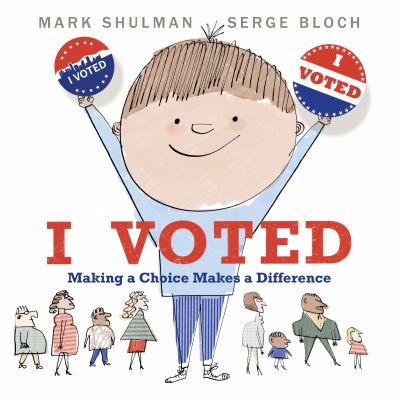By Marie Huey, Public Policy and Advocacy Coordinator

Mixed delivery is a hot topic in early care and education. Even with an extra half hour, December’s Ann Kaner-Roth Policy Hour titled “Mix It Up: Creating Synergy in a Diverse Delivery System” did not cover all of the facets of the term. However, the guests and audience highlighted central themes and questions.
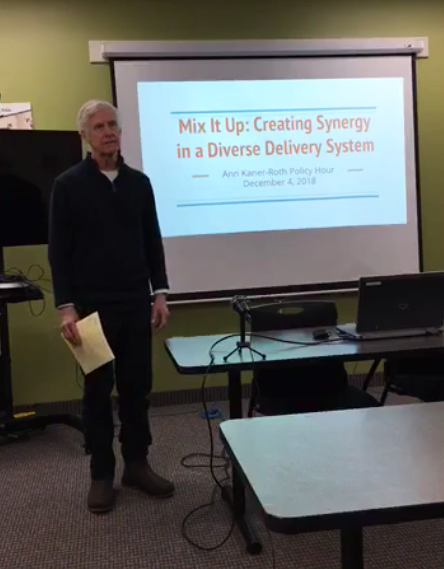
Todd Otis, consultant with Think Small and long-time advocate for quality early learning opportunities, hosted the event and introduced the guests. All presenters emphasized the importance of relationships in developing and supporting a mixed delivery system. As people in different parts of the field come together around young children, communication is key. Another theme that resonated throughout the presentations is that communities have different needs that cannot be addressed in one way. Minnesota is a diverse state, economically, demographically, and geographically. It is important to listen to what communities need in different parts of the state.
Defining Mixed Delivery
Mixed delivery means different things to different people. At a broad level, it means having a variety of services in different settings so that young children and families can access the one(s) they need to thrive. The Pre-K to Three Design Team defined it as, “a system—programs, providers and settings such as Head Start, licensed family and center-based child care programs, public schools and community –based organizations) that is supported with a combination of public funds and private funds.”
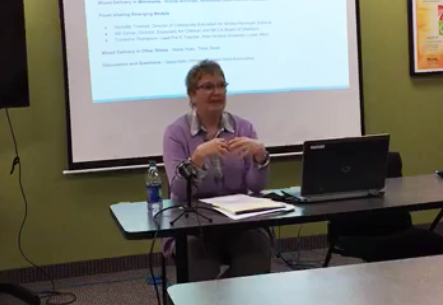
Bobbie Burnham, Director of Early Learning Services at the Minnesota Department of Education (MDE), shared about the Preschool Development Grant, which the department submitted in close coordination with the Governor’s Children’s Cabinet. The grant is heavily focused on mixed delivery for children birth to five. In that application the statement about mixed delivery is as follows:
“Currently, mixed delivery is defined as offering high-quality pre-kindergarten programming through a variety of programs, providers and settings (such as Voluntary PreK, School Readiness Plus, Head Start, licensed family and center child care, public schools, and community based organizations).
- In this way, a community can increase parent choice and the number and diversity of programs offering high-quality early learning and care experiences.
- Mixed Delivery allows communities to share resources and professional development, improves alignment and communication among providers, makes use of existing facilities, and requires fewer transitions for children.
MDE is currently working with early care and education leaders including community education directors, Head Start, MN Child Care Aware, Voices and Choices, elementary principals, charter school directors, and other community leaders to identify strategies that will engage all program types in designing a mixed delivery system that provides increased parental choice and meets the needs of each unique community.”
Burnham said, “Mixed delivery is a plan being built.”
Mixed Delivery Models
While the Preschool Development Grant application seeks to improve mixed delivery functionality, the current reality is that partnership is not the standard. There are 18 mixed delivery programs, meaning that the school districts partnered with a non-school entity to provide instruction. Several presenters mentioned that the quick turnaround for implementation of VPK and School Readiness Plus made it difficult for school districts to form meaningful relationships with child care programs in their area. MDE continues to work with principals and superintendents to support them in reaching out to local programs.
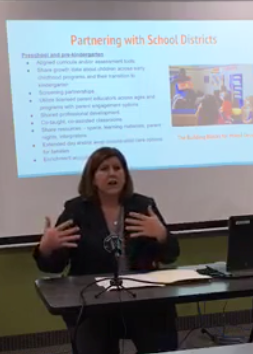
Michelle Trelstad, Director of Community Education for Anoka-Hennepin School District, spoke about the mixed delivery partnerships in her purview. She noted that school districts are pretty good at partnering with themselves, but they have not yet mastered partnering with others. She shared several programs that are a launching pad for mixed delivery. For instance, they worked with Head Start to develop a kindergarten to-go file that contains information and assessment data from the child’s time at Head Start which can be shared with the kindergarten teacher.
One large partnership project is the child care collaborative. Licensed parent educators who work for the district go out to licensed child care centers and family child care. They align work between the two and create opportunities for shared professional development and networking.
Anoka-Hennepin school district does not currently have space for child care for four-year-olds, which some districts do. However, they worked with a KinderCare in the area that had extra space.
Adult Basic Education (ABE) is one area that does not receive a lot of attention but may also be part of the larger mixed delivery system. Many parents who would benefit ABE could also benefit from quality child care. There may be an opportunity to partner with child care centers around that.
Important Considerations
Alli Zomer is Director of Operations at Especially for Children, a child care center with eight locations around the metro area. Especially for Children is a member of the Minnesota Child Care Association (MCCA), which includes 220 centers across the state. Zomer spoke on behalf of MCCA about how they are thinking about mixed delivery.
For her, mixed delivery means families being able to receive the service they need in the environment they choose. Parent voice is essential to creating a system that works for families in communities around the state. MCCA is committed to ensuring that care is high-quality, and they believe in focusing first on the children with the greatest need.
Part of the discussion is around which rules to use. Child care centers and family child care are licensed by DHS, which has different rules than public school teachers. That creates tension and can feel unfair. For instance, child care programs are required to supervise children while they use the bathroom. Schools, on the other hand, can allow children to use the bathroom independently. When two teachers are working side by side with different rules, that leads to confusion.
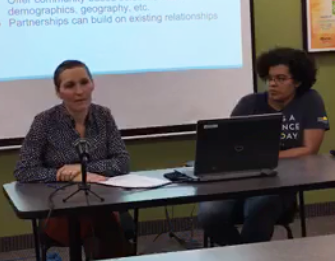
While the field of early care and education is very diverse, there is often a sense of ranking or hierarchy. Many child care providers have worked in the field for decades and have a wealth of knowledge and expertise. For various reasons, there is often a sense that the school district staff has greater status, and this can be deflating for providers. Zomer advocates for ensuring that all early care and education professionals are valued for their knowledge and respected.
First Hand Experience
Toniesha Thompson, lead PreK Teacher at a New Horizon Academy in Saint Paul, participated in a mixed delivery model in the past year. She worked with a Saint Paul Public School (SPPS) teacher at the New Horizon.
There were challenges because of the different requirements and expectations of each program. Toniesha works from 9:00 a.m. – 6:30 p.m., where as the SPPS teacher was there from 9:00 a.m. – 3:00 p.m. While this meant that Toniesha had extra time to develop relationships with parents and children, it also meant that the partner teacher missed out on these interactions. Some parents seemed to prefer talking with the SPPS teacher or started dropping their child off only for the time of the program. The set SPPS schedule was a challenge for some children. Since many arrived hours before the 9:00 a.m. curriculum start time, they were exhausted and struggled to stay engaged.
Toniesha enjoyed the detail with which the SPPS curriculum described their weekly activities, especially for parents. She enjoyed seeing the growth in the children both with regards to literacy and their ability to follow a routine. Overall, she enjoyed the partnership and stressed the importance of keeping communication open for it to be beneficial to both parties.
Mixed Delivery Around the Country
Minnesota is not alone in looking at the issue of mixed delivery. Other states are at various stages of building mixed delivery systems. The current discussion focuses mainly on three and four year old children. However, states disburse the money to programs in different ways. Some states award funding to private child care programs directly. Some focus on coordinating funds and programs in different communities. Others direct funding through school districts.
View the handout here with more specific information about Mixed Delivery in Other States.
Questions
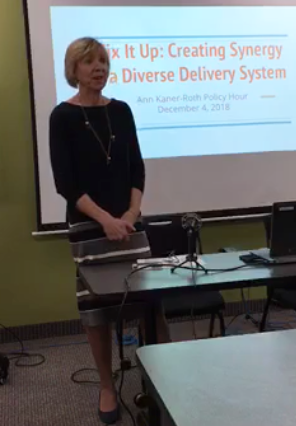
Many issues remain about what mixed delivery will look like (and what it even means!) Gayle Kelly, Executive Director of the Minnesota Head Start Association, asked the audience to share their thoughts. Some specific questions that came up in this discussion included:
How do we build meaningful partnerships and relationships that respect each individual’s knowledge and strengths?
How can each community best address the needs of their children and families?
What is the role of local government? School districts? State government? Private business? Parents?
Whose rules prevail? When school districts and DHS-licensed programs work together, which rules should be followed? What does that mean for non-partnering programs? How do teachers feel about that?
How can we ensure that children remain at the center, and that developmentally-appropriate practices are prioritized?
Potential Benefits
If a well-supported mixed delivery system were in place statewide, it would greatly benefit children ages birth to 5 and their families. (While the current policy discussion focuses on pre-kindergarten, a larger view includes all young children). Parents would be able to choose the program(s) that best fit their needs. A wide variety of programs would be able to flourish and complement each other.
Building relationships between people in the field would also benefit children and families. By truly sharing resources, partnering, and lifting each other up, early childhood professionals across settings could learn and grow.
For a recording of the entire presentation, click here.




